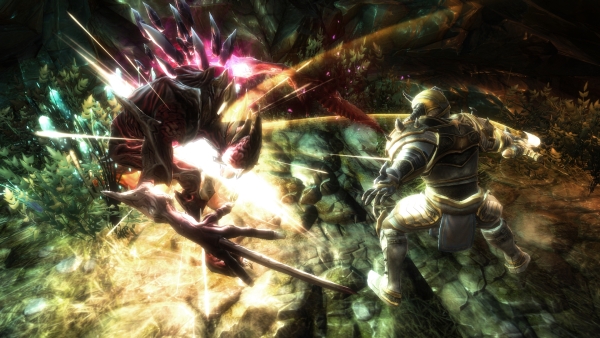
Imagine, if you will, that there was an action RPG that incorporated elements from games such as God of War, Fable, The Elder Scrolls series, Dragon Age, and Mass Effect. Now imagine that the development of this game involved Ken Rolston, the lead designer of The Elder Scrolls III: Morrowind and The Elder Scrolls IV: Oblivion, the lore of fantasy writer R.A. Salvatore, and the art of Todd McFarlane, creator of Spawn. Well, imagine no longer! Kingdoms of Amalur: Reckoning is on its way and is ready to drown you in an amalgam of role-playing goodness.
Platforms: PC, PS3 (Version Played), Xbox 360
Publisher: Electronic Arts, 38 Studios
Developer: Big Huge Engine, 38 Studios
Genre: Action-RPG Smorgasbord
Release Date: February 7, 2012
ESRB Rating: Mature
The demo starts you out with a bit of exposition, telling the story of the land and something about a war with an undying race called the Faes. The narrator continues on and details how the war against the Faes was long, bitter, and unchanging until one day when you, the player character, died. The scene then cuts to your character being wheeled on a cart to be dumped into a pile of corpses. After some character customization business, you wake up in said pile of corpses and start your adventure in the Well of Souls, the tutorial stage.
Right off the bat, walking feels clunky and unwieldy. The camera swings almost haphazardly around in an effort to track your character, but its sensitivity can thankfully be adjusted in the options. The most you can do is roll around to your heart’s content until you pick up some obligatory starter equipment. Your gear, once you collect it all, consists of a shield, a sword, a bow, daggers, and a staff for magic. All of these can be used together in whatever combinations you want, allowing for a great deal of freedom and choice in combat.
After picking up each weapon, the game will send baddies your way while teaching you how to use your new toys. Is a sword coming toward your head? Put up your shield at just the right time and deflect it! Follow this up with either a roll for a quick escape or lay down the hurt and try to chop off the other guy’s extremities. The dagger and the bow are for those with more roguish inclinations and the former can be used in Sneak mode in order to instantly kill unaware enemies. The staff is straightforward and shoots elemental bolts. This can be coupled with your magic spells for some pretty satisfying combos. You are delightfully not limited to one style of play as the game allows you to wield all of these weapons however you see fit in whatever combinations you want.
After the Well of Souls tutorial stage, you’re set free in the world for 45 minutes of play. The counter pauses when you’re in the menu and during conversations. The menu is pretty lackluster and basic, but it gets the job done. The conversations, however, are reminiscent of the Mass Effect dialogue wheel and a bit of the listed dialogue choices in Star Wars: Knights of the Old Republic. The camera closes up on the character models and does a disservice to them. When adventuring around, the game looks pretty and vibrant. But up close, the characters look like they were pulled from a free-to-play MMO. It’s a bit jarring after seeing the details and the ethereal quality in the environment.

These conversations with NPCs lead to various quests that are pretty standard for games of this type. Some of the tasks include fetching, collecting, and killing blank amounts of blank. Standard fare. You eventually meet up with a clairvoyant character on the road who tells you of your grand fate, or at least the fact that he can’t see what fate has in store for you. He sends you on your merry way to travel the land and help people. Or, if you’re somewhat of a closet homicidal maniac, you can toggle Aggressive Mode on and cut down any NPC in your path, ignoring your character’s duty. Very Chaotic Evil.
On your path to becoming a benevolent hero or psychopathic murderer, you will level up and accrue points for different Skills, Abilities, and Destinies. Skills include things like Alchemy, Persuasion, and Blacksmithing. Abilities are basically talent trees to help specialize your character. My choices reflected my goal of turning my character into a badass mage, so I put points into the Sorcery and gave myself an awesome staff-based area of effect attack. Destinies can be described as character classes and give you different stat boosts when activated. Again, there is an emphasis on choice and you’re not stuck with one archetype. The game’s Skills, Abilities, and Destinies offer some of the best customization I’ve seen to date.
Kingdoms of Amalur: Reckoning is shaping up to be a decent action RPG. It may not look like the most polished role-playing experience, but it definitely feels solid. It doesn’t hurt that it has three big names on the development side and their involvement can only help the game. It won’t replace The Elder Scrolls V: Skyrim as my go-to RPG, but it’s something I’ll seriously consider purchasing to quest around for a little bit each day. Or I could just go around murdering chickens and townfolk. Hooray for choices.







